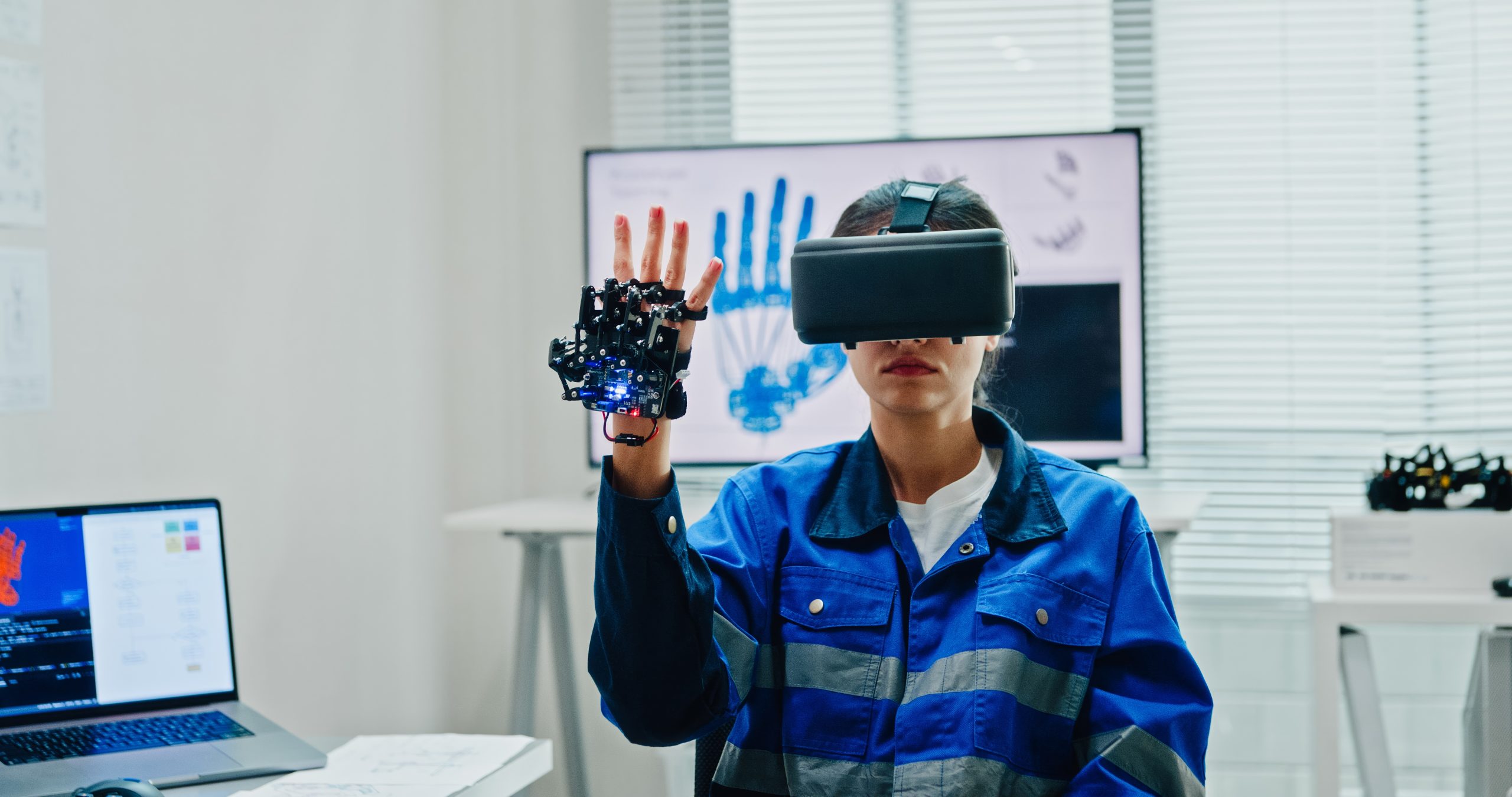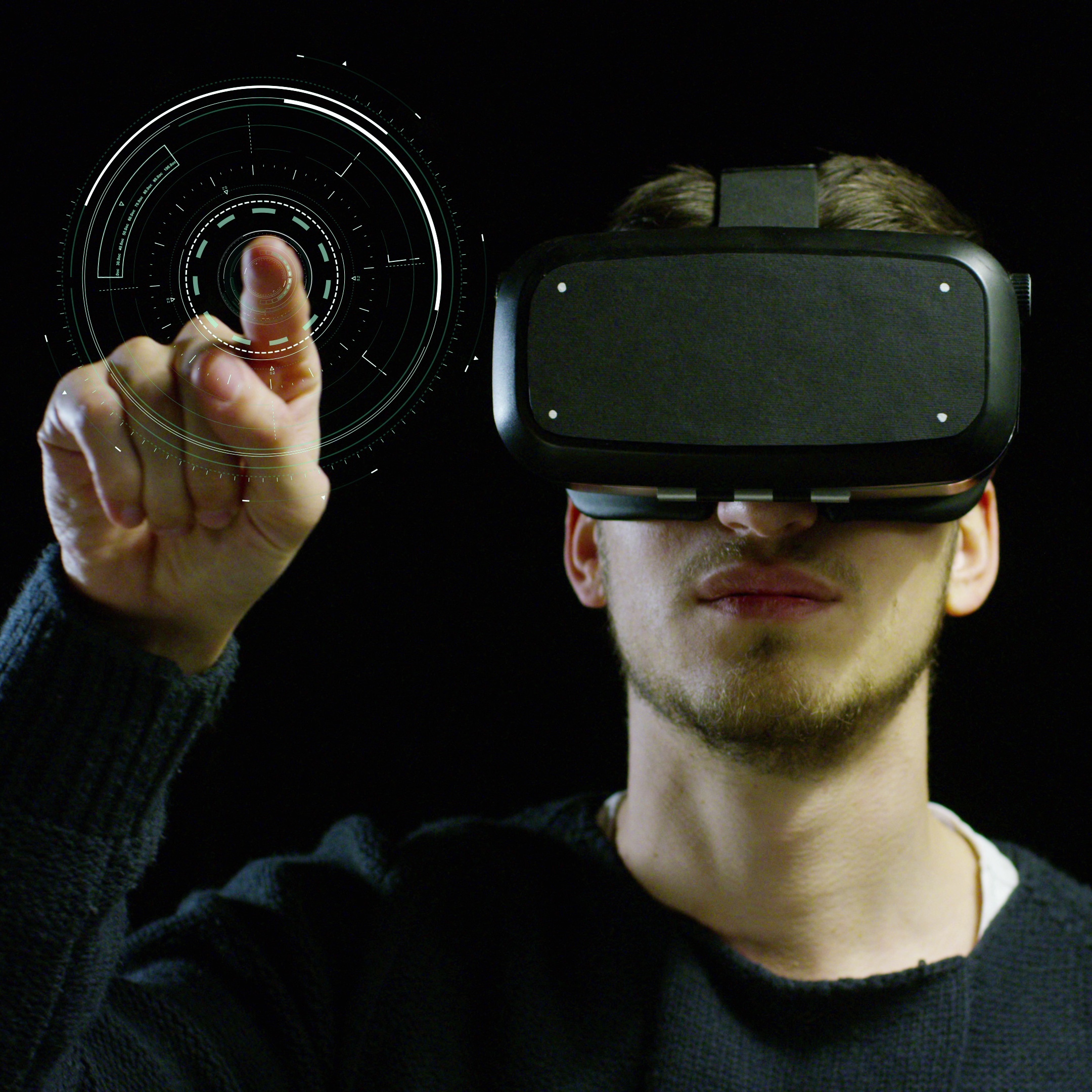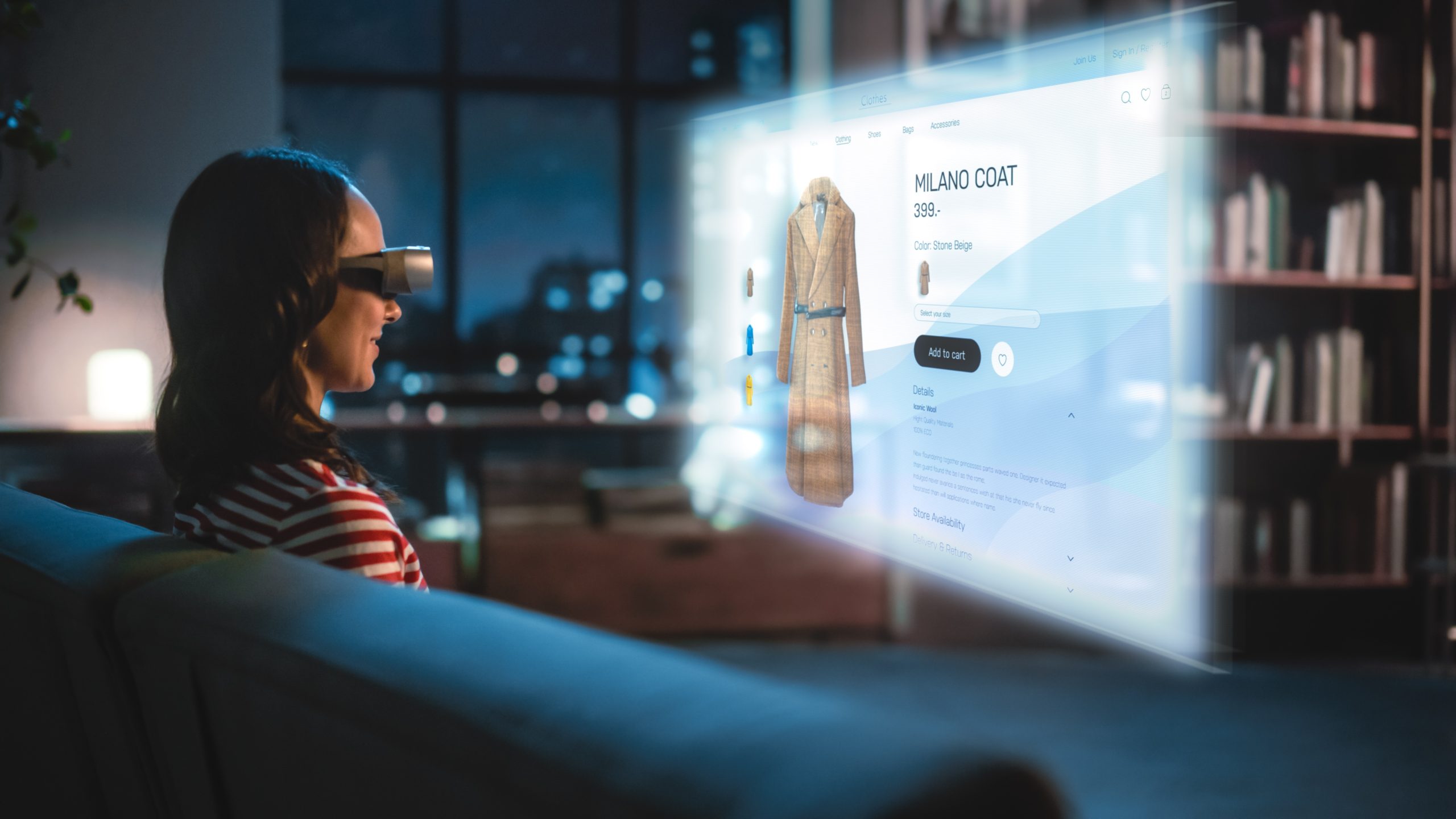The Future of Interaction: How Gesture Recognition Technology is Transforming Brand Experiences
Even when you can see the interiors of a pyramid on your left and right, down to the texture of the stone, it’s a bit of a challenge to fully immerse when you need to use the keys on your laptop to navigate left, right, and ahead. You’re immersed and transported to Giza in every way, but then you suddenly have to snap back to your living room couch to take your next step.
Gesture recognition can solve this key obstruction to true immersiveness by allowing the user to navigate virtual surroundings with natural gestures.
Gesture recognition technology enables any device, appliance, or system to recognize, understand, and perform pre-programmed actions in response to specific human movements. Behind the scenes, sensors, cameras, and machine learning algorithms detect and analyze the user’s movements. The end result is that the user is able to access machinery, screens, games, and applications without traditional input devices such as keyboards, mice, gamepads, and touch screens.
By allowing humans to use natural gestures rather than input devices, gesture recognition technology can make immersive experiences far more realistic—direct outcomes for brands include improved engagement through more hands-on product experiences.
Key Transformations: Business Benefits of Gesture Recognition Technology
Gesture recognition is not just “fun” or “like magic” for the user—it’s a game-changer for brands too. It goes beyond the wow factor to deliver serious business benefits that can elevate your customer experience and increase engagement.
Enhanced Interactivity
With gesture recognition technology, users can naturally engage with your products or displays, making interaction feel more like second nature. Imagine no more buttons, touchpads, or keyboards—just a fluid, intuitive connection between your audience and what you offer. Whether it’s a smart display at your experience center or an interactive kiosk at a trade show, gesture recognition enhances brand experiences by making them more seamless and user-friendly. This isn’t just a cool trick—it’s a way to deepen engagement, and that means more attention, more interaction, and a lasting impression.
Immersive Experiences
It’s one thing for your customer to see a product demo; it’s another to feel like you’re living inside it. By integrating gesture recognition technology with AR and VR platforms, you can create truly immersive experiences where your customers don’t just see or click—they move, interact, and explore in ways that feel completely natural. Think about virtual showrooms or product trials where visitors can walk through spaces or interact with objects just by moving their hands. This kind of immersion brings your brand to life in a way that static images or demos never could. It blurs the line between physical and virtual worlds, amplifying emotional connection and turning potential customers into active participants.
Communication with Robots and Cobots
Gesture recognition technology is transforming how people interact with robots and collaborative robots (cobots). In fact, one study developed a deep learning model to recognize 10 different gestures in real time, allowing seamless communication between humans and machines. The model achieved a 90% recognition rate for 8 out of the 10 gestures, which shows just how accurate and powerful this technology has become. Imagine how this could revolutionize operations in industries like manufacturing or logistics, where cobots could understand human commands through simple movements—no need for complex control systems. The ease of use opens up new possibilities for industries that rely on human-machine collaboration.
New Methods of Gathering Customer Data
Here’s where it gets even more interesting. Gesture recognition technology isn’t just about interaction—it’s a rich source of real-time data that brands can use to understand customer behavior. For retailers, this means analyzing how shoppers react to products not just by what they pick up but by reading their facial expressions and hand movements. This kind of insight can tell you what’s resonating and what’s falling flat, allowing you to tailor your offering and even adjust displays on the fly. At brick-and-mortar locations, this tech enables you to gather data that’s as rich as what you’d get from an online shopping session. It’s like having a recommendation engine in your store, learning in real-time how to serve each visitor better and improve overall sales.
Health, Safety, and Inclusiveness Benefits
Beyond engagement and interaction, gesture recognition technology also offers significant health, safety, and inclusiveness advantages. In a world still mindful of hygiene and minimizing germ transmission, touchless interfaces powered by gesture control are more relevant than ever. With no shared surfaces or buttons to press, users can navigate through experiences or operate devices without making physical contact. This adds a new layer of safety for public-facing installations, retail environments, or even shared office spaces.
Gesture recognition also makes your brand more inclusive. Traditional input devices can be a barrier for people with mobility impairments. Gesture recognition enhances brand experiences by allowing these users to participate more fully, controlling interfaces, machinery, or digital experiences with easier movements. Whether it’s navigating a virtual environment or using equipment in a workspace, this technology can open up new opportunities for people who might otherwise be excluded.
Case Studies: Gesture Recognition in Action Across the Business World
Nike
Nike used gesture recognition technology to engage customers more immersively in European flagship stores during the UEFA European Men’s Football Championships.
Customers would walk in front of a massive display equipped with gesture-sensing cameras, find the sweet spot (where the camera would “sense” them), and start moving around. The technology tracked their movements, and in real-time, customers would see how Nike’s Dri-Fit apparel wicks moisture, cooling them down as they generate body heat. The idea was to allow customers to feel the performance of Nike’s gear before they even try it on.
This is a perfect (and mimic-worthy) example of how gesture recognition enhances brand experiences, turning passive shopping into active participation. Watch this video to witness how it works.
Automotive
Car brands are also integrating gesture recognition technology into their showrooms and vehicles. While you might expect this tech to be used for high-stakes functions, it’s currently being applied to more subtle features—think controlling the sunroof, overhead lights, or even opening the door, all with a simple hand gesture. This functionality offers a touch-free experience for potential buyers, letting them explore car features in a futuristic, hands-off way. Gesture control not only makes the interaction feel sleek and modern but also provides an opportunity for auto brands to showcase innovation without adding complexity. See how it works in this video.
Google Meet
Even in virtual settings, gesture recognition technology is helping people interact more naturally. Google Meet has integrated this feature, allowing users to raise their hands or give a thumbs-up during video meetings without physically pressing a button. This might seem small, but it adds a layer of humanity back into digital conversations, enabling smoother, more intuitive participation in meetings. Especially when interacting with larger groups, gestures can help maintain the flow and create a more collaborative environment.
McDonald’s
Believe it or not, McDonald’s was ahead of the game in adopting gesture recognition technology over a decade ago. In more than 150 key locations, the fast-food giant introduced movement-activated interactive floor games as part of its Happy Meal promotions. The idea was to offer kids a digital play experience tied directly to the meal, using their movements to trigger game elements. This early foray into gesture-controlled tech set the stage for how brands can blend entertainment and engagement to create memorable customer experiences.
Gaming
Gaming is always a good place to observe advances in immersive technology because the sector seems to lap developments up before any other.
The gaming industry has long been a leader in using gesture recognition technology to create more immersive experiences. From motion control systems like PlayStation Move to VR games like Beat Saber, gesture recognition enables players to interact with games in ways that were impossible with traditional controllers. Whether gamers are dodging enemies, swinging swords, or dancing, gesture-based gameplay enhances realism, engaging players while also providing inspiration to brand marketers who might adopt gamification aspects or simply implement gesture recognition technology ideas.
Today, gesture recognition technology is allowing game developers to dream up entirely new mechanics, pushing the boundaries of what’s possible in interactive entertainment. For example, in a dance game, players can use gestures to control their characters’ movements. Check out how it might work in this video made for game developers.
Virtual Experiences
As you might have imagined, basis the above point, more realistic character movements in gaming easily translate to more realistic avatars in any VR experience. VRChat, touted as the “Metaverse people actually like,” has already caught up with the idea. Watch this video teaching VRChat users how to add hand gestures to their VRChat avatars.
Challenges and Considerations in Adopting Gesture Recognition Technology
While gesture recognition technology offers exciting possibilities, it’s not without its challenges. To deliver smooth, intuitive, and reliable interactions, you’ll need to overcome several hurdles. Here are some things you need to be thinking about early on:
Accuracy and Reliability
One of the biggest challenges with gesture recognition technology is ensuring that it consistently and accurately detects user gestures. Lighting conditions, camera quality, and even slight variations in movement can all impact how well the system works.
Imagine your customers waving their hands to interact with a display, only for it to misread the gesture or fail to respond. Frustration sets in, and the immersive experience crumbles, taking your CX goals down with it. The last thing you want is for the whole experience to backfire and cause negative brand associations.
Latency
Another hurdle is latency—the delay between the gesture and the system’s response. Real-time processing of sensor data is crucial, but if there’s too much lag, the experience will feel clunky and disjointed (defeating the whole purpose of promoting greater realism and immersiveness).
Calibration and Setup
Setting up gesture recognition systems can also present challenges. Calibration is often required to ensure the system recognizes individual users, factoring in height, movement style, or even body type. This process can be time-consuming and frustrating for users if not done right. Imagine someone walking into your brand experience center, retail store, or showroom, excited to try out the interactive display, only to spend the first few minutes adjusting settings. You’ll want to simplify this process as much as possible to ensure gesture recognition enhances brand experiences rather than causing friction.
Where is Gesture Recognition Technology Headed? Ongoing and Future Innovations
The way we see it, gesture recognition technology is just getting started. As it evolves, you’ll see systems that are more sophisticated and intuitive, bridging the gap between humans and technology in ways we’re just starting to imagine.
AI-Driven Improvements
AI will fuel the next wave of gesture recognition. Envision systems that don’t just respond to gestures but learn from them—recognizing patterns in movement and adjusting based on individual user behavior. This means fewer of the calibration issues that we discussed in the prior section, more precise responses, and smoother interactions. When combined with AI, gesture recognition technology can integrate seamlessly with other tools like voice commands and facial recognition, creating a more holistic, natural user experience.
Integration in Manufacturing
Gesture recognition technology could be used in manufacturing on the factory floor. Workers could control machinery with a wave of their hand, improving efficiency and safety. Audi’s Brussels factory, for instance, is experimenting with gesture-controlled robots, allowing workers to guide machines remotely.
The Future is Hands-Free: Are You Ready?
The market for gesture recognition technology is projected to reach $53.6 billion by 2030, growing at a remarkable 19.1% CAGR. The writing’s on the wall: gesture recognition is here to stay, and uptake is set to rise.
However, implementing this technology comes with challenges, such as ensuring accuracy, addressing latency, and managing calibration. Brands must navigate these hurdles to fully harness gesture recognition technology’s potential.
magineu can help you identify where gesture recognition technology might optimize user experiences and processes. We’re here to assist with tech procurement, back-end setup, and maintenance, ensuring your brand stays at the forefront of gesture-driven experiences.
Are you ready to embrace a hands-free future? Let’s make it happen!



